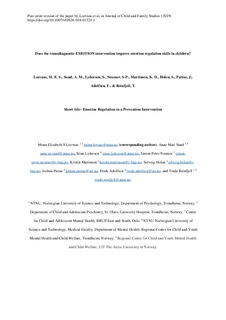| dc.contributor.author | Løvaas, Mona Elisabeth S | |
| dc.contributor.author | Sund, Anne Mari | |
| dc.contributor.author | Lydersen, Stian | |
| dc.contributor.author | Neumer, Simon-Peter | |
| dc.contributor.author | Martinsen, Kristin Dagmar | |
| dc.contributor.author | Holen, Solveig | |
| dc.contributor.author | Patras, Joshua | |
| dc.contributor.author | Adolfsen, Frode | |
| dc.contributor.author | Reinfjell, Trude | |
| dc.date.accessioned | 2019-11-29T12:05:02Z | |
| dc.date.available | 2019-11-29T12:05:02Z | |
| dc.date.created | 2019-04-16T13:53:48Z | |
| dc.date.issued | 2019 | |
| dc.identifier.citation | Journal of Child and Family Studies. 2019, 28 (3), 805-813. | nb_NO |
| dc.identifier.issn | 1062-1024 | |
| dc.identifier.uri | http://hdl.handle.net/11250/2631059 | |
| dc.description.abstract | Objectives
Emotion regulation is thought to be an important transdiagnostic process across internalizing disorders in youth, and the regulation of emotions is believed to play a central role in both adaptive and maladaptive development. Several preventive interventions focus on improving children’s emotion regulation skills, but research regarding the outcomes of emotion regulation skills are scarce.
Methods
We therefore investigated whether a new transdiagnostic indicated prevention intervention for anxiety and depressive symptoms, the EMOTION program, improves emotion regulation skills as reported by parents of children aged 8–12 years. Data from a large national cluster randomized control trial (RCT) study, Coping Kids, performed in Norway were used, including data from 601 children and their parents.
Results
Using mixed models, we found a decrease in dysregulation of emotions (Δ = .06, CI = (0.00 to .11), p = .040) and an increase in emotion regulation (Δ = .11, CI = (0.05 to .17) p < .001) in the intervention group compared to the control group.
Conclusions
The EMOTION intervention has a potential positive effect on children’s emotional regulation skills. One opportunity in transdiagnostic interventions lies in targeting common underlying processes in internalizing disorders and thereby reaching a larger proportion of the youth population than is possible with single-disorder approaches. | nb_NO |
| dc.language.iso | eng | nb_NO |
| dc.publisher | Springer Verlag | nb_NO |
| dc.title | Does the transdiagnostic EMOTION intervention improve emotion regulation skills in children? | nb_NO |
| dc.type | Journal article | nb_NO |
| dc.type | Peer reviewed | nb_NO |
| dc.description.version | acceptedVersion | nb_NO |
| dc.source.pagenumber | 805-813 | nb_NO |
| dc.source.volume | 28 | nb_NO |
| dc.source.journal | Journal of Child and Family Studies | nb_NO |
| dc.source.issue | 3 | nb_NO |
| dc.identifier.doi | 10.1007/s10826-018-01324-1 | |
| dc.identifier.cristin | 1692925 | |
| dc.relation.project | Norges forskningsråd: 228846 | nb_NO |
| dc.description.localcode | This is a post-peer-review, pre-copyedit version of an article published in [Journal of Child and Family Studies ] Locked until 7.1.2020 due to copyright restrictions. The final authenticated version is available online at: https://doi.org/10.1007/s10826-018-01324-1 | nb_NO |
| cristin.unitcode | 194,67,40,0 | |
| cristin.unitcode | 1920,18,0,0 | |
| cristin.unitcode | 194,65,35,5 | |
| cristin.unitname | Institutt for psykologi | |
| cristin.unitname | PH - Barne- og ungdomspsykiatrisk klinikk | |
| cristin.unitname | RKBU Midt-Norge - Regionalt kunnskapssenter for barn og unge - psykisk helse og barnevern | |
| cristin.ispublished | true | |
| cristin.fulltext | original | |
| cristin.qualitycode | 1 | |
